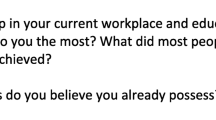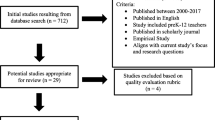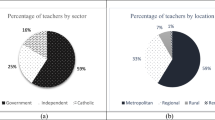Abstract
In the 1980s when research on effective schools surfaced the importance of ‘instructional leadership’ in the United States, skeptics wondered if this would be just another educational fad. Yet, 40 years later, the expectation for school principals to be ‘instructional leaders’ has become ubiquitous throughout much of the world. This systematic review of research used science mapping to gain insights into the growth and geographic distribution of this literature, as well as to identify key documents, authors, and topics. The authors used a variety of quantitative bibliometric analyses to examine 1206 Scopus-indexed journal articles on instructional leadership published between 1940 and 2018. The results affirm that the knowledge base on instructional leadership has not only increased in size, but also geographic scope. Contrary to expectations during the 1980s, instructional leadership has demonstrated remarkable staying power, growing into one of the most powerful models guiding research, policy and practice in school leadership. Despite this finding, both author co-citation and co-word analyses revealed the emergence of ‘integrated models of school leadership’ in which instructional leadership is enacted in concert with dimensions drawn from complementary leadership approaches. Key themes in the recent literature include studies of leadership effects on teachers and students, contexts for leadership practice, and means of developing instructional leaders.





Similar content being viewed by others
References
Bagby, G. (1972). Help wanted: Instructional leadership. NASSP Bulletin,56(367), 40–46.
Bamburg, J. D., & Andrews, R. L. (1991). School goals, principals, and achievement. School Effectiveness and School Improvement,2(3), 175–191.
Barth, R. S. (1986). On sheep and goats and school reform. Phi Delta Kappan,68(4), 293–296.
Barth, R. S. (2001). Teacher leader. Phi Delta Kappan, 82(6), 443–449.
Blasé, J., & Blasé, J. (2000). Effective instructional leadership: Teachers’ perspectives on how principals promote teaching and learning in schools. Journal of Educational Administration,38(2), 130–141.
Boberg, J. E., & Bourgeois, S. J. (2016). The effects of integrated transformational leadership on achievement. Journal of Educational Administration,54(3), 357–374.
Bossert, S. T., Dwyer, D. C., Rowan, B., & Lee, G. V. (1982). The instructional management role of the principal. Educational Administration Quarterly,18(3), 34–64.
Boyce, J., & Bowers, A. J. (2018). Toward an evolving conceptualization of instructional leadership as leadership for learning: Meta-narrative review of 109 quantitative studies across 25 years. Journal of Educational Administration,56(2), 161–182.
Bridges, E. M. (1967). Instructional leadership: A concept re-examined. Journal of Educational Administration,5(2), 136–147.
Bridges, E. M. (1982). Research on the school administrator: The state of the art, 1967–19801. Educational Administration Quarterly,18(3), 12–33.
Bush, T. (2013). Instructional leadership and leadership for learning: Global and South African perspectives. Education as Change,17(sup1), S5–S20.
Chen, C., & Chen, C. (2003). Mapping scientific frontiers. London: Springer.
Clarke, S., & O’Donoghue, T. (2017). Educational leadership and context: A rendering of an inseparable relationship. British Journal of Educational Studies,65(2), 167–182.
Coburn, C. E. (2005). Shaping teacher sensemaking: School leaders and the enactment of reading policy. Educational Policy,19(3), 476–509.
Copland, M. A. (2003). Leadership of inquiry: Building and sustaining capacity for school improvement. Educational Evaluation and Policy Analysis,25(4), 375–395.
Corey, S. M., Wellesley Foshay, A., & Mackenzie, G. N. (1951). Instructional leadership and the perceptions of the individuals involved. NASSP Bulletin,35(181), 83–91.
Cuban, L. (1988). The managerial imperative and the practice of leadership in schools. Albany, NY: Suny Press.
Darling-Hammond, L. (2003). Keeping good teachers: Why it matters, what leaders can do. Educational Leadership,60(8), 6–13.
Day, C. (2009). Capacity building through layered leadership: Sustaining the turnaround. In A. Harris (Ed.), Distributed leadership (pp. 121–137). Dordrecht: Springer.
Dwyer, D. C. (1984). The search for instructional leadership: Routines and subtleties in the principal's role. Educational Leadership,41(5), 32–37.
Edmonds, R. (1979). Effective schools for the urban poor. Educational Leadership,37(1), 15–24.
Fromm, G., Hallinger, P., Volante, P., & Wang, W. C. (2017). Validating a Spanish version of the PIMRS: Application in national and cross-national research on instructional leadership. Educational Management Administration & Leadership,45(3), 419–444.
Fullan, M. (2007). Leading in a culture of change. New York: Wiley.
Fullan, M., & Miles, M. B. (1992). Getting reform right: What works and what doesn't. Phi Delta Kappan,73(10), 745–752.
Geijsel, F., Sleegers, P., Leithwood, K., & Jantzi, D. (2003). Transformational leadership effects on teachers’ commitment and effort toward school reform. Journal of Educational Administration,41(3), 228–256.
Goddard, R., Goddard, Y., Sook Kim, E., & Miller, R. (2015). A theoretical and empirical analysis of the roles of instructional leadership, teacher collaboration, and collective efficacy beliefs in support of student learning. American Journal of Education,121(4), 501–530.
Goldring, E., Porter, A., Murphy, J., Elliott, S. N., & Cravens, X. (2009). Assessing learning-centered leadership: Connections to research, professional standards, and current practices. Leadership and Policy in Schools,8(1), 1–36.
Grissom, J. A., Loeb, S., & Master, B. (2013). Effective instructional time use for school leaders: Longitudinal evidence from observations of principals. Educational Researcher,42(8), 433–444.
Gronn, P. (2000). Distributed properties: A new architecture for leadership. Educational Management, Administration & Leadership,28(3), 317–338.
Gümüş, S., Bellibaş, M. S., Esen, M., & Gümüş, E. (2018). A systematic review of studies on leadership models in educational research from 1980 to 2014. Educational Management Administration & Leadership,46(1), 25–48.
Gurr, D., Drysdale, L., & Mulford, B. (2010). Australian principal instructional leadership: Direct and indirect influences. Magis: Revista Internacional De Investigación En Educación, 2(4), 299–314.
Hallinger, P. (2003). Leading educational change: Reflections on the practice of instructional and transformational leadership. Cambridge Journal of Education,33(3), 329–352.
Hallinger, P. (2005). Instructional leadership and the school principal: A passing fancy that refuses to fade away. Leadership and Policy in Schools,4(3), 221–239.
Hallinger, P. (2011a). A review of three decades of doctoral studies using the principal instructional management rating scale: A lens on methodological progress in educational leadership. Educational Administration Quarterly,47(2), 271–306.
Hallinger, P. (2011b). Leadership for learning: Lessons from 40 years of empirical research. Journal of Educational Administration,49(2), 125–142.
Hallinger, P. (2018). Bringing context out of the shadows of leadership. Educational Management Administration & Leadership, 46(1), 5–24.
Hallinger, P., & Heck, R. H. (1996). Reassessing the principal's role in school effectiveness: A review of empirical research, 1980–1995. Educational Administration Quarterly,32(1), 5–44.
Hallinger, P., & Heck, R. H. (1998). Exploring the principal's contribution to school effectiveness: 1980–1995. School Effectiveness and School Improvement,9(2), 157–191.
Hallinger, P., & Heck, R. H. (2010). Collaborative leadership and school improvement: Understanding the impact on school capacity and student learning. School Leadership and Management,30(2), 95–110.
Hallinger, P., & Kovačević, J. (2019). A bibliometric review of research on educational administration: Science mapping the literature, 1960 to 2018. Review of Educational Research, 89(3), 335-369.
Hallinger, P., & Liu, S. (2016). Leadership and teacher learning in urban and rural schools in China: Meeting the dual challenges of equity and effectiveness. International Journal of Educational Development, 51, 163–173.
Hallinger, P., & Murphy, J. F. (1985). Assessing the instructional management behavior of principals. The Elementary School Journal,86(2), 217–247.
Hallinger, P., & Wang, W. C. (2015). Assessing instructional leadership with the principal instructional management rating scale. Dordrecht: Springer.
Hallinger, P., Bickman, L., & Davis, K. (1996). School context, principal leadership, and student reading achievement. The Elementary School Journal,96(5), 527–549.
Harris, A. (2004). Distributed leadership and school improvement: Leading or misleading? Educational Management Administration & Leadership,32(1), 11–24.
Harris, A., Day, C., Hopkins, D., Hadfield, M., Hargreaves, A., & Chapman, C. (2013). Effective leadership for school improvement. London: Routledge.
Heck, R. H., & Hallinger, P. (2010). Collaborative leadership effects on school improvement: Integrating unidirectional-and reciprocal-effects models. The Elementary School Journal,111(2), 226–252.
Heck, R. H., Larsen, T. J., & Marcoulides, G. A. (1990). Instructional leadership and school achievement: Validation of a causal model. Educational Administration Quarterly,26(2), 94–125.
Hopkins, D. (2013). Instructional leadership and school improvement. In A. Harris, C. Day, D. Hopkins, M. Hadfield, A. Hargreaves, & C. Chapman (Eds.), Effective leadership for school improvement (pp. 65–81). London: Routledge.
Hoy, A. W., & Hoy, W. K. (2006). Instructional leadership: A research-based guide to learning in schools. Auckland, NZ: Pearson Education.
Knapp, M. S., Copland, M. A., Honig, M. I., Plecki, M. L., & Portin, B. S. (2010). Learning-focused leadership and leadership support: Meaning and practice in urban systems. Seattle, WA: Center for the Study of Teaching and Policy-University of Washington.
Krüger, M. L., Witziers, B., & Sleegers, P. (2007). The impact of school leadership on school level factors: Validation of a causal model. School Effectiveness and School Improvement,18(1), 1–20.
Leithwood, K. A. (1992). The move toward transformational leadership. Educational Leadership,49(5), 8–12.
Leithwood, K. A. (1994). Leadership for school restructuring. Educational Administration Quarterly,30(4), 498–518.
Leithwood, K. A. (2001). School leadership in the context of accountability policies. International Journal of Leadership in Education,4(3), 217–235.
Leithwood, K. A., & Sun, J. (2018). Academic culture: A promising mediator of school leaders’ influence on student learning. Journal of Educational Administration,56(3), 350–363.
Leithwood, K. A., Harris, A., & Hopkins, D. (2008). Seven strong claims about successful school leadership. School Leadership and Management,28(1), 27–42.
Leithwood, K. A., Patten, S., & Jantzi, D. (2010). Testing a conception of how school leadership influences student learning. Educational Administration Quarterly,46(5), 671–706.
Lieberman, A., & Pointer Mace, D. H. (2008). Teacher learning: The key to educational reform. Journal of Teacher Education,59(3), 226–234.
Louis, K. S., Leithwood, K. A., Wahlstrom, K. L., & Anderson, S. E. (2010). Investigating the links to improved student learning: Final report of research findings. Minneapolis, MN: University of Minnesota and Ontario Institute for Studies in Education/University of Toronto.
MacBeath, J., & Dempster, N. (Eds.). (2008). Connecting leadership and learning: Principles for practice. London: Routledge.
Marks, H. M., & Printy, S. M. (2003). Principal leadership and school performance: An integration of transformational and instructional leadership. Educational Administration Quarterly,39(3), 370–397.
Mestry, R., Moonsammy-Koopasammy, I., & Schmidt, M. (2013). The instructional leadership role of primary school principals. Education as Change,17(sup1), S49–S64.
Moher, D., Liberati, A., Tetzlaff, J., & Altman, D. G. (2009). Preferred reporting items for systematic reviews and meta-analyses: The PRISMA statement. Annals of Internal Medicine,151(4), 264–269.
Murphy, J. F. (1990). Principal instructional leadership. In L. L. Lotto & P. W. Thurston (Eds.), Advances in educational administration: Changing perspectives on the school (Volume I, Part B, pp. 163–200). Greenwich, CT: JAI Press.
Murphy, J. F., Elliott, S. N., Goldring, E., & Porter, A. C. (2007). Leadership for learning: A research-based model and taxonomy of behaviors. School Leadership and Management,27(2), 179–201.
National Commission on Excellence in Education. (1983). A nation at risk: The imperative for educational reform. The Elementary School Journal,84(2), 113–130.
Neumerski, C. M. (2013). Rethinking instructional leadership, a review: What do we know about principal, teacher, and coach instructional leadership, and where should we go from here? Educational Administration Quarterly,49(2), 310–347.
Ng, F. S. D., Nguyen, T. D., Wong, K. S. B., & Choy, K. W. W. (2015). Instructional leadership practices in Singapore. School Leadership & Management,35(4), 388–407.
O'Donnell, R. J., & White, G. P. (2005). Within the accountability era: Principals' instructional leadership behaviors and student achievement. NASSP bulletin,89(645), 56–71.
Price, D. J. D. S. (1965). Networks of scientific papers. Science,149(3683), 510–515.
Printy, S. M. (2007). Leadership for teacher learning: A community of practice perspective. Educational Administration Quarterly, 44(2), 187–226.
Printy, S. M., Marks, H. M., & Bowers, A. J. (2009). Integrated leadership: How principals and teachers share transformational and instructional influence. Journal of School Leadership,19(5), 504–532.
Qian, H., & Walker, A. (2013). How principals promote and understand teacher development under curriculum reform in China. Asia-Pacific Journal of Teacher Education,41(3), 304–315.
Robinson, V. M., Lloyd, C. A., & Rowe, K. J. (2008). The impact of leadership on student outcomes: An analysis of the differential effects of leadership types. Educational Administration Quarterly,44(5), 635–674.
Sammons, P., Davis, S., Day, C., & Gu, Q. (2014). Using mixed methods to investigate school improvement and the role of leadership: An example of a longitudinal study in England. Journal of Educational Administration,52(5), 565–589.
Scheerens, J. (Ed.). (2012). School leadership effects revisited: Review and meta-analysis of empirical studies. Dordrecht: Springer.
Sebastian, J., & Allensworth, E. (2012). The influence of principal leadership on classroom instruction and student learning: A study of mediated pathways to learning. Educational Administration Quarterly,48(4), 626–663.
Small, H. (1973). Co-citation in the scientific literature: A new measure of the relationship between two documents. Journal of the American Society for Information Science,24(4), 265–269.
Southworth, G. (2002). Instructional leadership in schools: Reflections and empirical evidence. School Leadership & Management,22(1), 73–91.
Spears, H. (1941). Can the line-and-staff principle unify instructional leadership? The bulletin of the National Association of Secondary School Principals,25(98), 25–31.
Spillane, J. P. (2006). Distributed leadership. San Francisco, CA: Jossey-Bass.
Spillane, J. P., Halverson, R., & Diamond, J. B. (2001). Investigating school leadership practice: A distributed perspective. Educational Researcher,30(3), 23–28.
Spillane, J. P., Halverson, R., & Diamond, J. B. (2004). Towards a theory of leadership practice: A distributed perspective. Journal of Curriculum Studies, 36(1), 3–34.
Spillane, J. P., Diamond, J. B., & Jita, L. (2003). Leading instruction: The distribution of leadership for instruction. Journal of Curriculum studies,35(5), 533–543.
Supovitz, J., Sirinides, P., & May, H. (2010). How principals and peers influence teaching and learning. Educational Administration Quarterly,46(1), 31–56.
Thoonen, E. E., Sleegers, P. J., Oort, F. J., & Peetsma, T. T. (2012). Building school-wide capacity for improvement: The role of leadership, school organizational conditions, and teacher factors. School Effectiveness and School Improvement,23(4), 441–460.
Tschannen-Moran, M. (2014). Trust matters: Leadership for successful schools. New York: Wiley.
van Eck, N. J., & Waltman, L. (2014). Visualizing bibliometric networks. In Y. Ding, R. Rousseau, & D. Wolfram (Eds.), Measuring scholarly impact (pp. 285–320). Cham, Dordrecht: Springer.
Wahlstrom, K. L., & Louis, K. S. (2008). How teachers experience principal leadership: The roles of professional community, trust, efficacy, and shared responsibility. Educational Administration Quarterly,44(4), 458–495.
Walker, A., & Hallinger, P. (2015). A synthesis of reviews of research on principal leadership in East Asia. Journal of Educational Administration,53(4), 554–570.
Wang, T. (2016). School leadership and professional learning community: Case study of two senior high schools in Northeast China. Asia Pacific Journal of Education,36(2), 202–216.
Weldy, G. R. (1979). Principals are instructional leaders it's a fact—Not a myth. NASSP Bulletin,63(423), 71–76.
White, H. D., & McCain, K. W. (1998). Visualizing a discipline: An author co-citation analysis of information science, 1972–1995. Journal of the American Society for Information Science,49(4), 327–355.
Willey, G. S. (1942). Instructional leadership in the junior and senior high schools of Denver. NASSP Bulletin,26(107), 61–65.
Witziers, B., Bosker, R. J., & Krüger, M. L. (2003). Educational leadership and student achievement: The elusive search for an association. Educational Administration Quarterly,39(3), 398–425.
York-Barr, J., & Duke, K. (2004). What do we know about teacher leadership? Findings from two decades of scholarship. Review of Educational Research,74(3), 255–316.
Zupic, I., & Čater, T. (2015). Bibliometric methods in management and organization. Organizational Research Methods,18(3), 429–472.
Author information
Authors and Affiliations
Corresponding author
Rights and permissions
About this article
Cite this article
Hallinger, P., Gümüş, S. & Bellibaş, M.Ş. 'Are principals instructional leaders yet?' A science map of the knowledge base on instructional leadership, 1940–2018. Scientometrics 122, 1629–1650 (2020). https://doi.org/10.1007/s11192-020-03360-5
Received:
Published:
Issue Date:
DOI: https://doi.org/10.1007/s11192-020-03360-5




